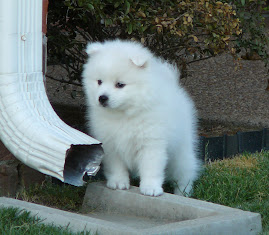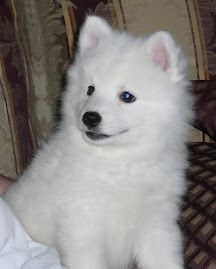 February 28, 2010
February 28, 2010- Always brush your dog first. Even though Japanese Spitz are not known for shedding, loose hairs often hide in the undercoat. A good brushing will remove these loose hairs, so as not to clog your drain. A brushing will also keep tangles from tightening after getting wet. Additionally, brushing helps to stimulate the natural oils in your dog's skin, which will help to prevent possible irritation from the shampoo.
- Assemble your supplies. Unless you have someone helping you during the bathing processing, you most likely will not be able to leave your pet unattended in the bathing area in order to retrieve a shampoo bottle or towel. It is much better to have everything you need assembled and at your finger tips. You will need a gentle shampoo (stay away from those with chemical sudsing agents), cotton balls or soft tissue, ear cleaner, an absorbent towel, a blow dryer, and, if possible, a non-slip grip for your bath tub. Now, its probably a good idea to let your dog go potty outside before you begin the actual bathing.
- Wet your dog down thoroughly. Because Japanese Spitz have thick, double coats, it can be hard to fully saturate your dog's fur. Nevertheless, this is necessary. Feed water directly into the coat. Begin at the back of your dog's neck and work down towards the tail. Then, do the belly and legs. When the time comes to wet your dog's face (save this for last), use a gentle spray or a large cup full of clean, warm water. Use care not to pour water into your dog's ears, as this could cause infection.
- Lather your dog. Use your fingers to gently massage the skin and to work the shampoo throughout both the outer and under coats. If your dog's coat is particularly thick, a heavy-duty bath brush will help. Make sure that you don't neglect the feet and the bottom, as these are the areas that tend to get soiled, thus causing odor. Also, wash the face, taking care not to get shampoo in the eyes, nose or ears.
- Rinse, Rinse, Rinse. The most frequent cause for skin irritation after a bath is soap residue. Rinse your dog until the water runs clear and your dog's entire coat feels free from soap. A water sprayer or hand-held shower head will with this. If you feel that you've gotten all the shampoo out of your dog's fur, then rinse some more. It is better to rinse too much than not enough. To rinse the face, use a large cup with clean, warm water. Cover your dog's eyes with one hand while rinsing the face, so as not to get soap in the eyes. If you prefer, you can apply a doggie conditioner to cut down on static, add more body, and to make your dog's hair more manageable. Rinse again until the water runs clear.
- Drying the coat. Wring excess water out of your dog's hair. Then, stand back and let your dog shake. This is your dog's instinctive method of drying. Then grab the absorbent towel and towel-dry/blot the coat thoroughly. Many short-haired dogs can air-dry, however, the Japanese Spitz is not one of those dogs. It is now time to pull out the trusty blow dryer. It will help if you can use one had to brush the same area that you are drying with the blow dryer. Since human blow dryers tend to get hot, be sure not to leave the dryer blowing on one spot for too long.
- Clean the ears. Pour the ear cleaning solution on the cotton ball or pad. Then, very gently, push it into your dog's ear until it stops. DO NOT force the pad after your meet resistance. Now, gently massage the ear with the cotton pad.
Important things to remember:
(1) Be sure to keep your dog warm until thoroughly dry. A Japanese Spitz can get chilled easily if the under coat isn't completely dry.
(2) Keep an eye on your dog if you let her outside immediately after bathing. Dogs like to dry themselves by rolling in the grass or in a nice dry patch of dirt. Of course, they might find that stinky thing again and roll in it. The last thing you want to have to do is have to give another bath so soon. Of course, if that does happen, at least now you're a pro and know exactly how to do it!












